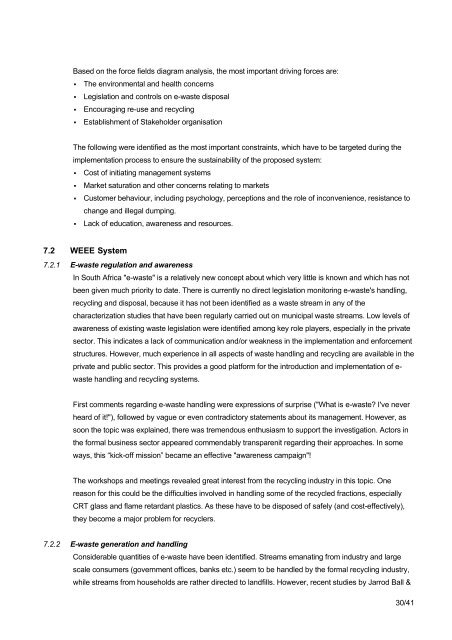E-WASTE ASSESSMENT IN SOUTH AFRICA - e-Waste. This guide
E-WASTE ASSESSMENT IN SOUTH AFRICA - e-Waste. This guide
E-WASTE ASSESSMENT IN SOUTH AFRICA - e-Waste. This guide
Create successful ePaper yourself
Turn your PDF publications into a flip-book with our unique Google optimized e-Paper software.
Based on the force fields diagram analysis, the most important driving forces are:▪ The environmental and health concerns▪ Legislation and controls on e-waste disposal▪ Encouraging re-use and recycling▪ Establishment of Stakeholder organisationThe following were identified as the most important constraints, which have to be targeted during theimplementation process to ensure the sustainability of the proposed system:▪ Cost of initiating management systems▪ Market saturation and other concerns relating to markets▪ Customer behaviour, including psychology, perceptions and the role of inconvenience, resistance tochange and illegal dumping.▪ Lack of education, awareness and resources.7.2 WEEE System7.2.1 E-waste regulation and awarenessIn South Africa "e-waste" is a relatively new concept about which very little is known and which has notbeen given much priority to date. There is currently no direct legislation monitoring e-waste's handling,recycling and disposal, because it has not been identified as a waste stream in any of thecharacterization studies that have been regularly carried out on municipal waste streams. Low levels ofawareness of existing waste legislation were identified among key role players, especially in the privatesector. <strong>This</strong> indicates a lack of communication and/or weakness in the implementation and enforcementstructures. However, much experience in all aspects of waste handling and recycling are available in theprivate and public sector. <strong>This</strong> provides a good platform for the introduction and implementation of e-waste handling and recycling systems.First comments regarding e-waste handling were expressions of surprise ("What is e-waste? I've neverheard of it!"), followed by vague or even contradictory statements about its management. However, assoon the topic was explained, there was tremendous enthusiasm to support the investigation. Actors inthe formal business sector appeared commendably transparenit regarding their approaches. In someways, this “kick-off mission” became an effective "awareness campaign"!The workshops and meetings revealed great interest from the recycling industry in this topic. Onereason for this could be the difficulties involved in handling some of the recycled fractions, especiallyCRT glass and flame retardant plastics. As these have to be disposed of safely (and cost-effectively),they become a major problem for recyclers.7.2.2 E-waste generation and handlingConsiderable quantities of e-waste have been identified. Streams emanating from industry and largescale consumers (government offices, banks etc.) seem to be handled by the formal recycling industry,while streams from households are rather directed to landfills. However, recent studies by Jarrod Ball &30/41
















